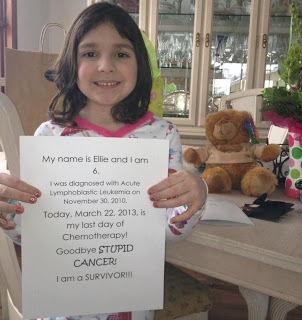 |
| Why we fund research - so heroes like Ellie Bloechl can say "goodbye" to childhood cancer. |
Have you heard the great news? Thanks to your amazing support, ALSF recently awarded $7 million in medical research grants to scientists searching for new cures and better treatments for kids with cancer. That’s $7 million that you have helped us to raise by holding or donating to a lemonade stand, attending one of our fun special events, donating through a sponsors’ campaign, making an online donation, running a race as part of Team Lemon, or by supporting the Foundation in another way. Every dollar counts and case in point - these dollars certainly add up.
These grants were awarded to doctors and researchers, at 24 institutions and universities in 14 states across the country, totaling 42 new grants. This brings us to a total of more than 340 pediatric cancer research projects that ALSF has funded across the U.S. and in Canada. That being said, no matter where the research is conducted, when better treatments and cures are found – our childhood cancer heroes everywhere can benefit.
We don't just fund research in a variety of geographic locations, but also across a variety of types of childhood cancer. Unlike many types of adult cancer, childhood cancer is comprised of more than 20 subtypes, which adds to the challenge of finding effective treatments for each and every one of these subtypes. Following in the footsteps of our founder Alex who simply stated that, “all children want their tumors to go away,” this latest round of grant funding supports projects focusing on several types of childhood cancer including acute lymphoblastic leukemia, acute myeloid leukemia, brain tumors, Diffuse Intrinsic Pontine Glioma (DIPG), glioblastoma, neuroblastoma, medulloblastoma, osteosarcoma, rhabdomyosarcoma, sarcoma, and more.
The complete list of grants that were recently awarded is below, so remember - the next time you see an Alex’s Lemonade Stand in your area or if you’re thinking about making a donation to ALSF, you can feel confident that your contributions are helping us get one step closer to finding cures for all kids with cancer.
THANK YOU!
Innovation Awards 2013
Baylor College of Medicine, Houston, TX
Nabil Ahmed, M.D.
Multispecific T Cells for Adoptive Immunotherapy of Pediatric High Grade Glioma(HGG)
Nabil Ahmed, M.D.
Multispecific T Cells for Adoptive Immunotherapy of Pediatric High Grade Glioma(HGG)
Baylor College of Medicine, Houston, TX
Stephen Gottschalk, M.D.
Engager T cells for the Adoptive Immunotherapy of Pediatric Malignancies
Stephen Gottschalk, M.D.
Engager T cells for the Adoptive Immunotherapy of Pediatric Malignancies
Cedar-Sinai Medical Center, West Hollywood, CA
Sandra Orsulic, Ph.D.
An Intersection of Cell Metabolism and Differentiation in Childhood Sarcoma
Sandra Orsulic, Ph.D.
An Intersection of Cell Metabolism and Differentiation in Childhood Sarcoma
Cincinnati Children’s Hospital Medical Center, Cincinnati, OH
Columbia University Medical Center, New York, NY
Darrell Jiro Yamashiro, M.D., Ph.D.
Identification of TFAP4 (Transcription Factor AP-4/Activating Enhancer BindingProtein) as a Potential Master Regulator/Synthetic Lethal Gene of MYCNAmplified Neuroblastoma
Darrell Jiro Yamashiro, M.D., Ph.D.
Identification of TFAP4 (Transcription Factor AP-4/Activating Enhancer BindingProtein) as a Potential Master Regulator/Synthetic Lethal Gene of MYCNAmplified Neuroblastoma
Dana-Farber Cancer Institute, Boston, MA
Charles Roberts, M.D., Ph.D.
Therapeutically Targeting a Tumor Suppressor Complex in Aggressive PediatricCancers
Charles Roberts, M.D., Ph.D.
Therapeutically Targeting a Tumor Suppressor Complex in Aggressive PediatricCancers
Dana-Farber Cancer Institute, Boston, MA
***Loren Walensky, M.D., Ph.D.
Reactivating Apoptosis in Refractory Pediatric Cancer by Molecular Inhibitionof MCL-1
***Loren Walensky, M.D., Ph.D.
Reactivating Apoptosis in Refractory Pediatric Cancer by Molecular Inhibitionof MCL-1
Duke University, Durham, NC
Corinne Mary Linardic, M.D., Ph.D.
Therapeutic Potential of the MST1/Hippo Tumor Suppressor Pathway in AlveolarRhabdomyosarcoma
Corinne Mary Linardic, M.D., Ph.D.
Therapeutic Potential of the MST1/Hippo Tumor Suppressor Pathway in AlveolarRhabdomyosarcoma
Lucile Packard Children’s Hospital at Stanford University School of Medicine, Palo Alto, CA
James Chen, Ph.D.
Next-Generation Therapies for Hedgehog Pathway-Dependent Tumors
James Chen, Ph.D.
Next-Generation Therapies for Hedgehog Pathway-Dependent Tumors
***Massachusetts General Hospital, Boston, MA
David Langenau, M.D.
Novel Therapeutic Targets in Relapse T-cell Acute Lymphoblastic Leukemia
David Langenau, M.D.
Novel Therapeutic Targets in Relapse T-cell Acute Lymphoblastic Leukemia
Northwestern University Medical School, Chicago, IL
Richard Longnecker, Ph.D.
An Oncolytic Herpes Simplex Virus Restricted in Entry to Neuroblastoma Cells
Richard Longnecker, Ph.D.
An Oncolytic Herpes Simplex Virus Restricted in Entry to Neuroblastoma Cells
Research Institute of the McGill University Health Center, Montreal, Canada
William Foulkes, M.D., Ph.D.
DICER1, MicroRNAs and Pediatric Cancer: An Emerging Story
William Foulkes, M.D., Ph.D.
DICER1, MicroRNAs and Pediatric Cancer: An Emerging Story
St. Jude Children’s Research Hospital, Memphis, TN
Michael Dyer, Ph.D.
Novel Targeted Therapies for Rhabdomyosarcoma
Michael Dyer, Ph.D.
Novel Targeted Therapies for Rhabdomyosarcoma
***The Children’s Hospital of Philadelphia, Philadelphia, PA
Garrett M. Brodeur, M.D.
Nanoparticle Delivery of Therapeutic Agents in Neuroblastomas
Garrett M. Brodeur, M.D.
Nanoparticle Delivery of Therapeutic Agents in Neuroblastomas
The Children’s Hospital of Philadelphia, Philadelphia, PA
Michael D. Hogarty, M.D.
Epigenetic Characterization of the Neuroblastoma Driver Genes ARID1A and ARID1B
Michael D. Hogarty, M.D.
Epigenetic Characterization of the Neuroblastoma Driver Genes ARID1A and ARID1B
University of California at Santa Cruz, Santa Cruz, CA
Camilla Forsberg, Ph.D.
Defining the Role of a Novel, Developmentally Restricted Hematopoietic StemCell in Pediatric Leukemias
Camilla Forsberg, Ph.D.
Defining the Role of a Novel, Developmentally Restricted Hematopoietic StemCell in Pediatric Leukemias
University of Chicago, Chicago, IL
Jianjun Chen, Ph.D.
Development of MicroRNA-Nanoparticles to Treat Childhood Acute LeukemiaCarrying MLL Rearrangements
Jianjun Chen, Ph.D.
Development of MicroRNA-Nanoparticles to Treat Childhood Acute LeukemiaCarrying MLL Rearrangements
University of Pennsylvania, Philadelphia, PA
Nadia Dahmane, Ph.D.
Mechanisms Regulating Medulloblastoma Progression
Nadia Dahmane, Ph.D.
Mechanisms Regulating Medulloblastoma Progression
University of Texas, Houston, TX
Laurence Cooper, M.D., Ph.D.
Pre-Clinical Testing of T cells Coded with CARs for DIPG
Laurence Cooper, M.D., Ph.D.
Pre-Clinical Testing of T cells Coded with CARs for DIPG
Young Investigator Awards 2013
Baylor College of Medicine, Houston, TX
Jason T. Yustein, M.D., Ph.D.
Dissecting and Targeting the Wnt Signaling Pathway in Metastatic Osteosarcoma
Baylor College of Medicine, Houston, TX
Jason T. Yustein, M.D., Ph.D.
Dissecting and Targeting the Wnt Signaling Pathway in Metastatic Osteosarcoma
Children’s Hospital Boston, Boston, MA
Glenn MacLean, Ph.D.
Genetic Dissection of Trisomy 21-TMD Using Human Pluripotent Stem Cells
Glenn MacLean, Ph.D.
Genetic Dissection of Trisomy 21-TMD Using Human Pluripotent Stem Cells
Children’s Hospital Boston, Boston, MA
Samantha Morris, Ph.D.
Investigating the Role of Circadian Rhythm in the Progression of Acute MyeloidLeukemia
Samantha Morris, Ph.D.
Investigating the Role of Circadian Rhythm in the Progression of Acute MyeloidLeukemia
Dana-Farber Cancer Institute, Boston, MA
Hao-Ru Jessie Hsu, Ph.D.
The Role of Prmt1 in Osteosarcoma Initiation and Metastasis
Hao-Ru Jessie Hsu, Ph.D.
The Role of Prmt1 in Osteosarcoma Initiation and Metastasis
Dana-Farber Cancer Institute, Boston, MA
Andrew A. Lane, M.D., Ph.D.
Histone Modification and Hmgn1 Overexpression as Drivers of B-ALL with Polysomy21
Andrew A. Lane, M.D., Ph.D.
Histone Modification and Hmgn1 Overexpression as Drivers of B-ALL with Polysomy21
**Dana-Farber Cancer Institute, Boston, MA
Shizhen Zhu, M.D., Ph.D.
The Role of PTPRD as a Tumor Suppressor in Neuroblastoma Pathogenesis
Shizhen Zhu, M.D., Ph.D.
The Role of PTPRD as a Tumor Suppressor in Neuroblastoma Pathogenesis
Duke University Medical Center, Durham, NC
David Van Mater, M.D., Ph.D.
Dissecting the Hierarchy of Tumor Cell Differentiation Using Dual RecombinaseTechnology in a Novel Mouse Model of Rhabdomyosarcoma
David Van Mater, M.D., Ph.D.
Dissecting the Hierarchy of Tumor Cell Differentiation Using Dual RecombinaseTechnology in a Novel Mouse Model of Rhabdomyosarcoma
Fred Hutchinson Cancer Research Center, Seattle, WA
Heather Helton, M.D.
Genomic Alterations in ETV6 Predict Outcome in Pediatric AML
Heather Helton, M.D.
Genomic Alterations in ETV6 Predict Outcome in Pediatric AML
**Lucile Packard Children’s Hospital at Stanford University School of Medicine, Palo Alto, CA
Cigall Kadoch, Ph.D.
Reversing the Oncogenic Roles of Misdirected Chromatin Remodeling in SynovialSarcoma
Cigall Kadoch, Ph.D.
Reversing the Oncogenic Roles of Misdirected Chromatin Remodeling in SynovialSarcoma
Lucile Packard Children’s Hospital at Stanford University School of Medicine, Palo Alto, CA
Jun Ni, Ph.D.
Oncogenic Hedgehog Pathway Activation by a Putative Rho GTPase-ActivatingProtein
Jun Ni, Ph.D.
Oncogenic Hedgehog Pathway Activation by a Putative Rho GTPase-ActivatingProtein
Massachusetts General Hospital, Boston, MA
Jessica Blackburn, Ph.D.
PRL3 as a Novel Therapeutic Target for Relapsed T-cell Acute LymphoblasticLeukemia
Jessica Blackburn, Ph.D.
PRL3 as a Novel Therapeutic Target for Relapsed T-cell Acute LymphoblasticLeukemia
Mayo Clinic Jacksonville, Jacksonville, FL
Takahisa Kanekiyo, M.D., Ph.D.
LRP1 and Angiogenesis in Pediatric Malignant Glioma
Takahisa Kanekiyo, M.D., Ph.D.
LRP1 and Angiogenesis in Pediatric Malignant Glioma
**Memorial Sloan Kettering Cancer Center, New York, NY
Charalambos Kaittanis, Ph.D.
Multifunctional Nanomaterials for the Prevention of Radiotherapy's Side Effectsand Childhood Cancers
Charalambos Kaittanis, Ph.D.
Multifunctional Nanomaterials for the Prevention of Radiotherapy's Side Effectsand Childhood Cancers
St. Jude Children’s Research Hospital, Memphis, TN
Kathryn Roberts, Ph.D.
Genetic Profiling and Experimental Modeling of High-risk Acute LymphoblasticLeukemia
Kathryn Roberts, Ph.D.
Genetic Profiling and Experimental Modeling of High-risk Acute LymphoblasticLeukemia
The Children’s Hospital of Philadelphia, Philadelphia, PA
Robert Schnepp, M.D., Ph.D.
Defining the Mechanism by which LIN28B acts as an Oncogene in Neuroblastoma
The Johns Hopkins University School of Medicine, Baltimore, MD
Brian Ladle, M.D., Ph.D.
Epigenetic Regulation of T cell Activation and Immunotherapy
Robert Schnepp, M.D., Ph.D.
Defining the Mechanism by which LIN28B acts as an Oncogene in Neuroblastoma
The Johns Hopkins University School of Medicine, Baltimore, MD
Brian Ladle, M.D., Ph.D.
Epigenetic Regulation of T cell Activation and Immunotherapy
University of California Berkeley, Berkeley, CA
Miller Huang, Ph.D.
Characterization of the Role of Chromosome 1p Deletion in MYCN-AmplifiedNeuroblastoma
Miller Huang, Ph.D.
Characterization of the Role of Chromosome 1p Deletion in MYCN-AmplifiedNeuroblastoma
University of California Berkeley, Berkeley, CA
Erin Simonds, Ph.D.
Targeted Inhibition of Signaling Networks in Pediatric Glioblastoma Stem Cells
Erin Simonds, Ph.D.
Targeted Inhibition of Signaling Networks in Pediatric Glioblastoma Stem Cells
University of Pennsylvania, Philadelphia, PA
Jennifer Kalish, M.D., Ph.D.
Dissecting the Mechanism of Overgrowth and Tumorigenesis in Beckwith-WiedemannSyndrome
Jennifer Kalish, M.D., Ph.D.
Dissecting the Mechanism of Overgrowth and Tumorigenesis in Beckwith-WiedemannSyndrome
**Washington University, St. Louis, MO
Laura Schuettpelz, M.D., Ph.D.
The Regulation of Hematopoietic Stem Cell Function by Granulocyte-ColonyStimulating Factor
Laura Schuettpelz, M.D., Ph.D.
The Regulation of Hematopoietic Stem Cell Function by Granulocyte-ColonyStimulating Factor
Epidemiology Awards 2013
The Children’s Hospital of Philadelphia, Philadelphia, PA
Richard Aplenc, M.D.
Clinical Epidemiology Studies in Children's Oncology Group Clinical Trials
Richard Aplenc, M.D.
Clinical Epidemiology Studies in Children's Oncology Group Clinical Trials
University of California Berkeley, Berkeley, CA
Anand Chokkalingam, Ph.D.
Role of Fetal Growth in Pediatric Rhabdomyosarcoma
Anand Chokkalingam, Ph.D.
Role of Fetal Growth in Pediatric Rhabdomyosarcoma
Washington University, St. Louis, MO
Kimberly Johnson, Ph.D.
Identification of Risk Factors for Pediatric Brain Tumors in a High RiskPopulation
Kimberly Johnson, Ph.D.
Identification of Risk Factors for Pediatric Brain Tumors in a High RiskPopulation
**denotes award funded by Northwestern Mutual
*** denotes award partially funded by the Cure4Cam Childhood Cancer Foundation
July 12, 2013

